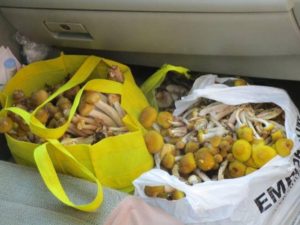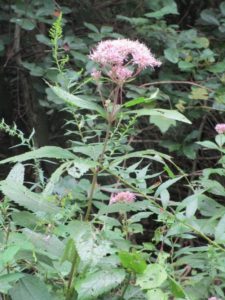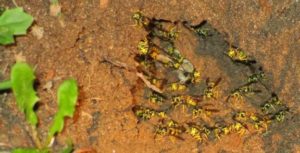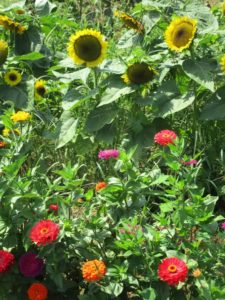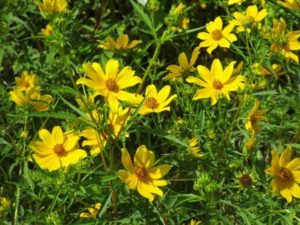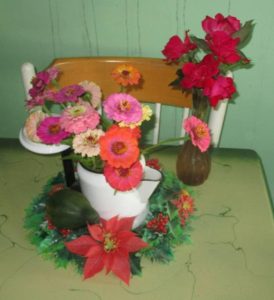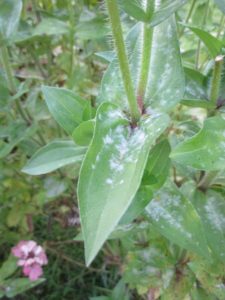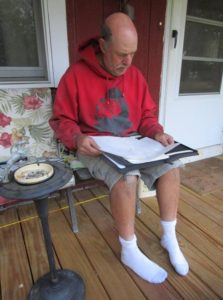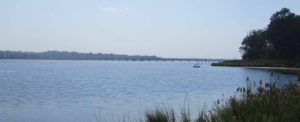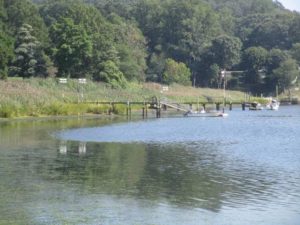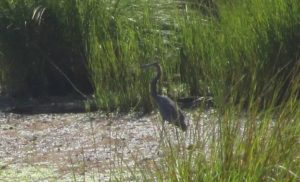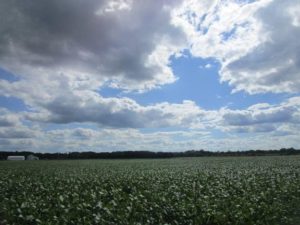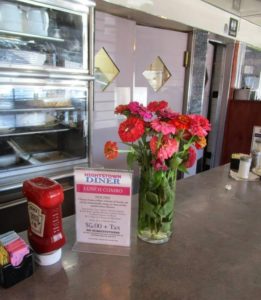Notes from Garden and Afield: Sept 3-10, 2017
Article and photos by Joe Sapia
Note: The yard references are to my house in the section of Monroe between Helmetta and Jamesburg in South Middlesex County. My yard is in a Pine Barrens outlier on the Inner Coastal Plain, the soil is loamy, and my neighborhood is on the boundary of Gardening Zones 6b (cooler) and 7a (warmer). Notes and photographs are for the period covered, unless otherwise noted.
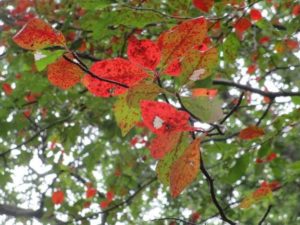 A black gum, “Nyssa sylvattica,” changes color at Cranberry Bog in the Pine Barrens around Helmetta.
A black gum, “Nyssa sylvattica,” changes color at Cranberry Bog in the Pine Barrens around Helmetta.
CHANGING COLORS IN THE PINE BARRENS AROUND HELMETTA: Black gum trees, ““Nyssa sylvattica,” are obvious with their leaves changing colors for the season. “Fall foliage,” meaning the changing colors as colder weather approaches, is a misnomer, because, here, in the Pine Barrens around Helmetta, changing colors are noticeable beginning about July 15 to 31. I look for the peak of the coloring October 13 in wet areas and October 20 in dry areas, but, really, it is impossible to pinpoint a peak. If there is even a peak, because there may not be a uniform turning of colors.
“OPIENKI” MUSHROOMS, PINE BARRENS AROUND HELMETTA: As I drove a paved road through Jamesburg Park today, I saw a car parked at the woods and a woman at the car. She wore yoga pants, a short-sleeve pullover shirt, and sneakers, pants untucked — not really dressed as a woodswoman. So, I took a guess at what she was doing.
Mushrooms? I asked.
She said yes.
What kind, honey mushrooms?, I said.
The woman — Lana, who lived a few miles away from the site — said she did not know the name to tell me. Then, I noticed what sounded to be an Eastern European accent.
“Opienki”? I asked.
Yes, she smiled. How did you know that name?
A grandmother from Poland, I said.
Lana is from the Ukraine. She was picking edible mushrooms of the genus “Armillaria,” known by Polish people as “opienka” singular and “opienki” plural. “Pien” means stump in Polish and these mushrooms grow along the stumps of dead oaks. Hence, they also are known as “stumpies” — and “tan and yellow stumpies” because of their color and, of course, where they are found. But the general public probably would know them best by their common name, “honey mushrooms.”
Lana had bags filled with mushrooms in her car. (See the photos, which she let me take.)
Journalisticly, I am publishing this to inform people. In a neighborly way, I am hesitant to publish this because PICK THE WRONG MUSHROOM AND, AT BEST, YOU WILL GET SICK, AND, AT WORST, YOU WILL DIE.
I am 60-years-old and have been in these woods my whole life, and have heard stories from them going back another 50 or 60 years to when my maternal family settled here, and I will confidently pick ONLY ONE mushroom in the Pine Barrens around Helmetta: opienka. In the Jersey Midlands as a whole, I will confidently pick ONLY TWO: the second one, a morel, which I am familiar with on the Piedmont — say, at such areas as Princeton and Sourland Mountain.
I am “somewhat confident” to pick two more. But I made it to 60 and “somewhat confident” does not cut it. Remember the adage: There are bold mushroom pickers and there are old mushroom pickers. There are no old AND bold mushroom pickers.
If one must pick mushrooms, three bits of advice, even for the experienced picker: One, know how to call emergency responders, telephone 911; two, the telephone number of New Jersey Poison Control, 800-222-1222; and three, save one mushroom, perhaps on your kitchen counter, so doctors know the mushroom one ate.
I said good-bye to Lana, warning her of ticks, which can pass along disease such as Lyme, and chiggers, which will get one itching, beginning about 36 hours after leaving the woods, and scratching like crazy for days. (Me, man who got chiggers a week ago, here, in the Pine Barrens around Helmetta. Me, stupid man because I was not thinking and did not avoid grassy areas.)
(Dedicated to Grandma Annie Poznanski Onda, born 1885 in Poland, died 1972 in the Pine Barrens around Helmetta. And a big thank you to Ralph “Rusty” Richards, woodsman extraordinaire of the Pine Barrens around Helmetta, who continues to be a local woods mentor to me.)
Lana’s “opienki” mushrooms in the Pine Barrens around Helmetta.
ALSO IN THE PINE BARRENS AROUND HELMETTA: Look for fall bloomers, such as asters. Joe Pye weed, “Eutrochium purpureum,” remains blooming – and will do so until about October. Queen Anne’s lace, “Daucus carota,” continues blooming to about November. The seed heads of punks, or cat-tails, genus “Typha,” were fluffing as summer passes.
Joe Pye weed in bloom near the Ditch in the Pine Barrens around Helmetta.
CHIGGERS IN THE PINE BARRENS AROUND HELMETTA: I did a brief hike Friday, Sept. 1, and began itching around Sunday morning – chigger bites! Fortunately, I did not get a bad case, a bit of itching here and there on my legs. I first encountered chiggers, here, in about 2004. Some view chiggers as a Southern species moving north; Others will say we already had them up here. I knew of chiggers from hiking in the Pine Barrens down in South Jersey. The bottom line is they itch! So, I will scratch for a few days, then life will go on until the next round of chiggers. (A tip: Avoid grassy areas such as those I walked in on my hike. I just was not thinking.)
MA, GRANDPA, AND THE LOCAL PINE BARRENS: Perhaps I was not thinking of chiggers on Sept. 1 because my mind was elsewhere. Earlier that day, I had mailed in a donation to my church, Holy Trinity Roman Catholic Church in Helmetta, and a request for a Mass to be said in Grandpa Mike Onda’s honor October 11– the 100th anniversary of his death in Helmetta from tuberculosis at 35–years-old. He left a 32-year-old widow, Annie Poznanski Onda, and three children 5-years-old and younger. One of those children was my mother, Sophie Onda Sapia, who was 3 when her father died. Her only memory of her father in later years was of her with him at Shekiro’s Pond in Helmetta. September 1 was the 22nd anniversary of Ma’s death at 81 in 1995. On this anniversary, I visited Shekiro’s Pond.
PESTS IN THE YARD: Neighbor Tom DeRose contacted me on the night of Labor Day, wanting to show me something in his yard. So, in the dark with flashlights, Tom and I were looking into a hole – perhaps big enough to shove in a few golf balls – of yellow jacket wasps. Ugh! They have scared me since I was a kid playing Army in this same neighborhood with Eddie Kasubinski. I pointed down the street at “The Swamp,” where Eddie and I got attacked – not by an opposing army, but by “yellow jacks.” I ran up the street crying. My father heard me, rushed into the backyard, saw the yellow jacks attacking me, grabbed my Army jacket, which had yellow jacks in it, and threw it aside. A number flew out of the jacket. I had got stung twice. Yellow jacks can be aggressive and multiple stingers. So, I advised Tom to stay away from his side yard until the cold weather sets in or spray a pesticide into the hole.
The yellow jacket nest in Tom DeRose and Trisha Miller DeRose’s side yard.
LAURINO FARMS: I was out in Monmouth County and stopped by Laurino Farms on Route 537 (between Laird and Swimming River Roads) in Colts Neck. There, I picked up a favorite of mine, white peaches, along with a jar of cranberry preserves. A shout out to Bobby Laurino, whom I saw briefly – personally, Bobby has patiently answered my gardening questions and he is an inspiration for me growing zinnias this year. And, more importantly, a shout out to Bobby for what he does for feeding the needy, including helping the Soul Kitchen restaurants (www.jbjsoulkitchen.org) in Red Bank and Toms River, founded by rock and roll star Jon Bon Jovi and his wife, Dorothea Bongiovi, who live in Middletown, Monmouth County, to support the needy. For example, Laurino provides space at his farm for Soul Kitchen to grow food organically. Dorothea said, “Bobby is an amazingly generous person, not only with his contribution of land to the Soul Kitchen so we could raise our own vegetables, (but) he is generous with his time, his knowledge, his spirit. I am not sure if all farmers are as optimistic as Bobby, but he has a positive can-do attitude that maybe all farmers need. Farming is an unbelievably difficult life, with many uncontrollable variables: temperature, rain, sun, insects (Bobby does not use pesticides), animals. I have enormous respect for anyone who grows food for others.” (And a shout out to Dorothea, who handles herself with class and humility. Over the summer, Dorothea received a Volunteer Leadership Award in the New Jersey State Governor’s Jefferson Awards for Public Service for her work with Soul Kitchen. “I was very surprised and humbled by the Jefferson award,” Dorothea said.)
Zinnias and sunflowers at Laurino Farms in Colts Neck, Monmouth County.
DRIVE-BY NATURALIST, “BIDENS” FLOWERS: Although I know the yellow flowers of the genus “Bidens” are adorning unplowed farmland and disturbed areas, it still amazes me when I come across fields of these flowers. I was driving in southern Monroe and came across this batch, next to acres of soybeans.
Yellow flowers of the genus “Bidens” in southern Monroe.
IN THE YARD AND GARDEN: The zinnias and Knock Out roses continue to bloom earnestly.
Zinnias, Knock Out roses, and a gourd, all from the my yard or garden, decorate the antique porcelain-top table in my kitchen. One of Ma’s old coffeepots is used as a vase.
MY BELOVED ZINNIAS: While still flowering wonderfully, the zinnias appear to have contracted powdery mildew. So, I will be dealing with this.
Apparently powdery mildew on the zinnias.
IN THE GARDEN: My summer crop, except for the zinnias, was a disaster. The sweet corn was undeveloped, probably because of too much rain and I should have planted in a bigger block to foster pollination, but it was harvestable and tasty. Too much rain translated into no cucumbers, no cantaloupe. Very few tomatoes, because something ate the tops off the plants.
MECHKOWSKI FARM: Timmy Mechkowski farms in Helmetta. He reported good crops of sweet corn, beets, stringbeans, carrots, broccoli, cabbage, and onions. “Tomatoes were decent until the end, when we starting getting the rain.” Timmy reported a bad year for peppers, potatoes, and blackberries. The Mechkowski farm is one of my favorite places.
Sitting on the front porch of his house, Timmy Mechkowski goes over his planting list.
Timmy Mechkowski’s dog, Abby, probably the most beautiful and most gentle dog I have ever met.
NAVESINK RIVER: The Navesink River drains about 95 square miles in the Red Bank area of Monmouth County. It abuts the hilly geological formation that separates the Inner and Outer Coastal Plains. The river sits on the Outer Coastal Plain side. These photos were taken downstream of the Ocean Bridge from the Middletown side. The bridge connects Middletown and Rumson. The Navesink River is one of my favorite places in the Jersey Midlands.
On the Navesink River, looking toward the Oceanic Bridge connecting Rumson, left, and Middletown, right.
Along the Navesink River.
DRIVE-BY NATURALIST, GREAT BLUE HERON: As I was leaving the Navesink River, I noticed a great blue heron, “Ardea Herodias” – a large bird I am in awe of.
The great blue heron along the Navesink River.
BIG SKY COUNTRY, MONROE TOWNSHIP: As the Jersey Midlands continue to develop, there is more a loss of big sky views. But the area between the Applegarth and Wyckoff’s Mills sections of Monroe is still a holdout. Here, there are wonderful views over soy bean fields and cornfields.
Between Monroe’s Applegarth and Wyckoff’s Mills sections, looking over a soybean field toward Route 33.
Between Monroe’s Applegarth and Wyckoff’s Mills sections, looking toward Cranbury, with corn growing to the right and soybeans to the left.
THE FLIP SIDE OF BAMBI: I have published photographs of beautiful deer in nature. I need to point out the flip side: deer on farmland and in garden. Years ago, I was talking to a farmer who grew corn on the state’s Assunpink Wildlife Management Area in western Monmouth County. The farmer paid no rent, but he had to leave a percentage of his crop to feed wildlife. The way I recall the story: “The problem is,” the farmer said, “the deer don’t know which 75 percent is mine and which 25 percent is theirs.” As Jersey Midlands nature writer John McPhee has written, “Deer, in my opinion, are rats with antlers, roaches with split hooves, denizens of the dark primeval suburbs. Deer intensely suggest New Jersey.”
OCEAN TEMPERATURES: Atlantic Ocean temperatures on the New Jersey coast were in the range of about 69 to 72 degrees during the weekend of September 9-10.
SUNRISE/SUNSET: For September 10, Sunday, to September 16, Saturday, the sun will rise about 6:35 to 6:40 a.m. and set about 7:10. For September 17, Sunday, to September 23, Saturday, the sun will rise about 6:40 to 6:45 and set about 6:55 to 7:05. The fall equinox of nearly equal daylight and sunlight is September 22, Friday.
THE NIGHT SKY: This week, in the pre-sunrise sky, I saw the constellation Orion for the first time this season – Colder weather is coming with the winter constellations. The moon is waning after the September 6 full moon. The new moon is September 20, Wednesday. The next full moon is the Full Harvest Moon October 5, Thursday.
WEATHER: The National Weather Service forecasting station for the area is at http://www.weather.gov/phi/.
Joey’s zinnias at the Hightstown Diner, in Hightstown, Mercer County.
Joe Sapia, 60, is a lifelong Monroe resident. He is a Pine Barrens naturalist and an organic vegetable-fruit gardener. He gardens the same backyard plot as did his Italian-American father, Joe Sr., and his Polish-immigrant, maternal grandmother, Annie Poznanski Onda. Both are inspirations for his food gardening. Joe is active with the Rutgers University Master Gardeners/Middlesex County program. He draws inspiration on the Pine Barrens around Helmetta from his mother, Sophie Onda Sapia, who lived her whole life in these Pines, and his Grandma Annie. Joe’s work also is at @JosephSapia on Twitter.com, along with Facebook.com on the Jersey Midlands page.

